Continuous suturing with two anterior layers reduces post-operative complications and hospitalization time in pancreaticoenterostomy
- PMID: 27401981
- PMCID: PMC4940953
- DOI: 10.1186/s12876-016-0482-8
Continuous suturing with two anterior layers reduces post-operative complications and hospitalization time in pancreaticoenterostomy
Abstract
Background: Most complications after pancreaticoduodenectomy (PD) were relation to pancreaticoenterostomy. We improved a new method of pancreaticoenterostomy that included the continuous suturing of the jejunum and the stump of the pancreas end-to-side with one layer posteriorly and two layers anteriorly. To evaluate the safety and efficiency of this new method, we introduced this retrospectively compared trial.
Methods: We compared 45 patients who had undergone pancreaticoduodenectomy with either the regular interrupted suturing method or the new continuous mattress suturing method in our hospital from September 2011 to March 2014.
Results: Although the total operation times were not reduced, the suturing time for the pancreaticoenterostomies in the continuous suture group (11.3 ± 1.8 min) was greatly reduced compared with that for the interrupted suture group (14.1 ± 2.9 min, p = 0.045). Importantly, the continuous mattress suturing method significantly decreased short-term post-operative complications, including pancreatic leakage (p = 0.042). Furthermore, shorter hospitalization times were observed in the continuous mattress suture group (12.3 ± 5.0 d) than in the interrupted suture group (24.2 ± 11.6 d, p = 0.000).
Conclusions: Continuous mattress suturing is a safe and effective pancreaticoenterostomy method that leads to reduced complications and hospitalization times.
Keywords: Continuous mattress suturing; Pancreatic leakage; Pancreaticoduodenectomy; Pancreaticoenterostomy.
Figures
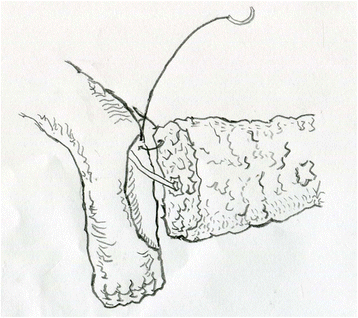
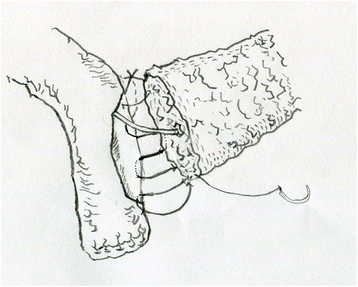
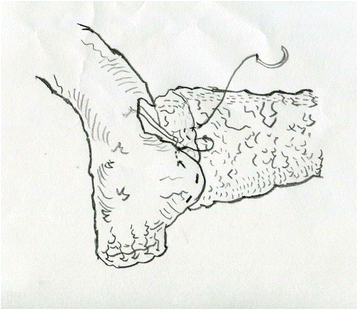
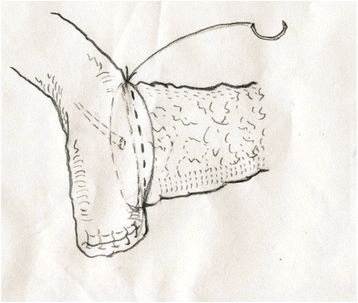
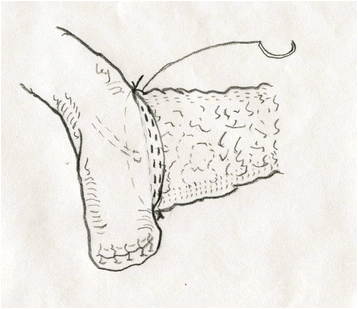
Similar articles
-
Pancreaticojejunostomy with double-layer continuous suturing is associated with a lower risk of pancreatic fistula after pancreaticoduodenectomy: a comparative study.Int J Surg. 2015 Jan;13:84-89. doi: 10.1016/j.ijsu.2014.11.034. Epub 2014 Dec 4. Int J Surg. 2015. PMID: 25481836
-
Pancreatic fistula after pancreaticoduodenectomy: a comparison between the two pancreaticojejunostomy methods for approximating the pancreatic parenchyma to the jejunal seromuscular layer: interrupted vs continuous stitches.World J Gastroenterol. 2007 Oct 28;13(40):5351-6. doi: 10.3748/wjg.v13.i40.5351. World J Gastroenterol. 2007. PMID: 17879405 Free PMC article.
-
Continuous versus interrupted suture techniques of pancreaticojejunostomy after pancreaticoduodenectomy.J Surg Res. 2015 Feb;193(2):590-7. doi: 10.1016/j.jss.2014.07.066. Epub 2014 Aug 5. J Surg Res. 2015. PMID: 25175768
-
Reliability of continuous suture of pancreaticojejunostomy after pancreaticoduodenectomy.Hepatogastroenterology. 2011 Nov-Dec;58(112):2132-9. doi: 10.5754/hge10314. Hepatogastroenterology. 2011. PMID: 22024085
-
Measures to prevent pancreatic fistula after pancreatoduodenectomy: a comprehensive review.Arch Surg. 2009 Nov;144(11):1074-80. doi: 10.1001/archsurg.2009.193. Arch Surg. 2009. PMID: 19917946 Review.
Cited by
-
Pancreaticojejunostomy-a review of modern techniques.Langenbecks Arch Surg. 2020 Feb;405(1):13-22. doi: 10.1007/s00423-020-01855-6. Epub 2020 Jan 23. Langenbecks Arch Surg. 2020. PMID: 31975148 Free PMC article. Review.
-
One hundred consecutive pancreatic resections using a novel pancreatico-jejunostomy technique.Langenbecks Arch Surg. 2024 Jun 7;409(1):176. doi: 10.1007/s00423-024-03366-0. Langenbecks Arch Surg. 2024. PMID: 38847886
References
MeSH terms
LinkOut - more resources
Full Text Sources
Other Literature Sources
Medical

